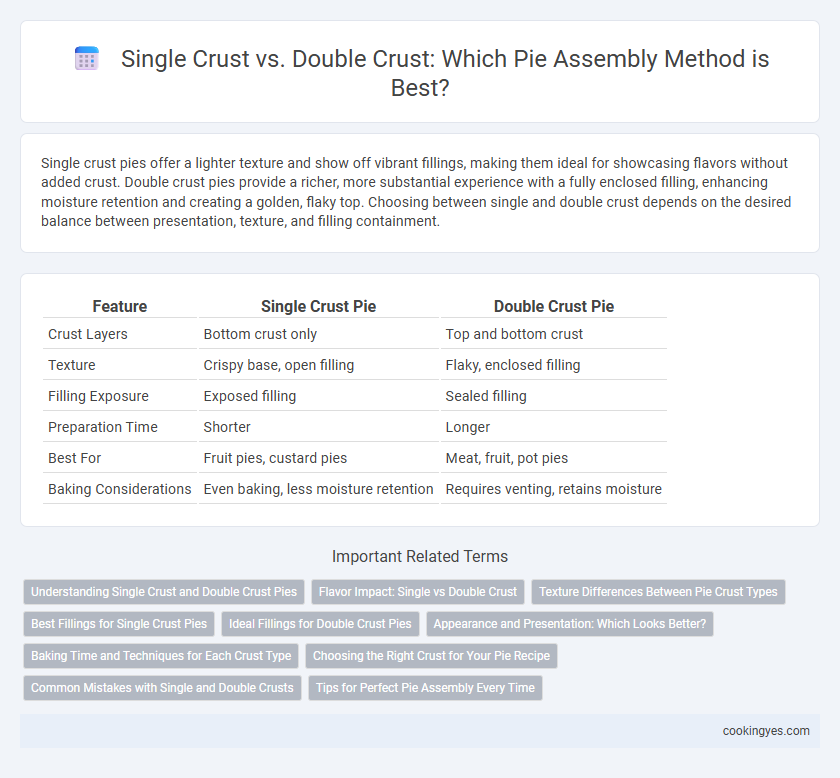Single crust pies offer a lighter texture and show off vibrant fillings, making them ideal for showcasing flavors without added crust. Double crust pies provide a richer, more substantial experience with a fully enclosed filling, enhancing moisture retention and creating a golden, flaky top. Choosing between single and double crust depends on the desired balance between presentation, texture, and filling containment.
Table of Comparison
| Feature | Single Crust Pie | Double Crust Pie |
|---|---|---|
| Crust Layers | Bottom crust only | Top and bottom crust |
| Texture | Crispy base, open filling | Flaky, enclosed filling |
| Filling Exposure | Exposed filling | Sealed filling |
| Preparation Time | Shorter | Longer |
| Best For | Fruit pies, custard pies | Meat, fruit, pot pies |
| Baking Considerations | Even baking, less moisture retention | Requires venting, retains moisture |
Understanding Single Crust and Double Crust Pies
Single crust pies consist of only a bottom pastry shell filled with sweet or savory ingredients, allowing the filling's flavors to stand out and often bake with a crisp, exposed surface. Double crust pies feature both a bottom and top pastry layer, creating a sealed environment that retains moisture, enhances texture contrast, and supports a variety of fillings including fruit, custard, and meat mixtures. Understanding the difference between single crust and double crust pies is essential for selecting the appropriate assembly technique to achieve desired taste, texture, and presentation outcomes.
Flavor Impact: Single vs Double Crust
A single crust pie offers a lighter, more balanced flavor profile by allowing the filling's natural taste to shine through without being overshadowed by additional pastry. Double crust pies provide a richer, more indulgent experience as the top and bottom layers of buttery crust add texture and a complementary, flaky flavor that enhances the overall taste. Choosing between single or double crust impacts the pie's flavor intensity and mouthfeel, aligning with different dessert preferences.
Texture Differences Between Pie Crust Types
Single crust pies offer a tender, flaky texture that emphasizes the filling, while double crust pies provide a crisp, sturdy outer layer balancing both crust and filling. The top crust in double crust pies adds an extra buttery crunch, contrasting with the softer base crust. Texture variations arise from differing fat distributions and baking times, making single crust pies lighter and double crust pies heartier.
Best Fillings for Single Crust Pies
Single crust pies excel with moist fillings such as pumpkin, custard, and chiffon because they provide a stable base without the need for a top crust to contain juices. Fruit fillings like apple, cherry, and blueberry also perform well when thickened adequately to prevent sogginess. Single crusts allow the flavors and textures of these fillings to stand out while offering a flaky, buttery contrast.
Ideal Fillings for Double Crust Pies
Double crust pies are ideally suited for fruit fillings like apple, cherry, and blueberry, which release juices during baking that are best contained by a top crust, preventing soggy bottoms and providing a golden, flaky seal. Thick, chunky fillings such as mincemeat and savory mixtures also benefit from the double crust, as the top layer locks in moisture and enhances the pie's structural integrity. This style of pie assembly supports fillings that require longer baking times, ensuring even cooking and balanced texture.
Appearance and Presentation: Which Looks Better?
A single crust pie offers a smooth, sleek surface that showcases fillings like fruit or custard, enhancing visual appeal with a glossy or lattice-topped finish. Double crust pies feature a fully enclosed top layer that provides a rustic and hearty appearance, often serving as a canvas for decorative cutouts or intricate patterns. Presentation preferences vary, with single crusts highlighting vibrant fillings and double crusts emphasizing texture and craftsmanship.
Baking Time and Techniques for Each Crust Type
Single crust pies typically require a shorter baking time, usually around 45-50 minutes, as the exposed filling cooks faster and the crust only bakes from one side. Double crust pies need a longer baking time, approximately 60-75 minutes, to ensure both the bottom and top crusts are fully cooked and golden brown. Techniques for single crust pies often involve blind baking to prevent sogginess, while double crust pies benefit from venting the top crust to allow steam to escape, promoting even cooking and a flaky texture.
Choosing the Right Crust for Your Pie Recipe
A single crust pie typically features a sturdy base that highlights the filling's texture and flavor, ideal for fruit or custard pies where a crisp bottom is desired. Double crust pies, with both top and bottom layers, provide a protective, enclosed environment, perfect for juicy fillings like apple or cherry that benefit from steam retention and a golden, flaky top. Selecting the right crust depends on the pie's moisture content and presentation preference, as well as the desired balance between crispness and tenderness in the final bake.
Common Mistakes with Single and Double Crusts
Common mistakes with single crust pies include underbaking the crust or not venting the filling properly, leading to a soggy bottom or overflowing during baking. Double crust pies often suffer from undercooked bottom crusts due to the top crust insulating the filling, and improper sealing can cause filling leakage. Overworking the dough in both styles results in tough crusts, while insufficient chilling before baking compromises flakiness and structural integrity.
Tips for Perfect Pie Assembly Every Time
For perfect pie assembly, single crust pies require careful sealing of the edges with an egg wash to ensure a golden, crisp finish and prevent sogginess. Double crust pies benefit from venting techniques such as slits or decorative cutouts, allowing steam to escape and avoiding a soggy bottom. Use chilled dough, minimal handling, and proper browning times for both crust types to achieve a flaky, tender texture.
Single crust vs double crust for pie assembly Infographic

 cookingyes.com
cookingyes.com